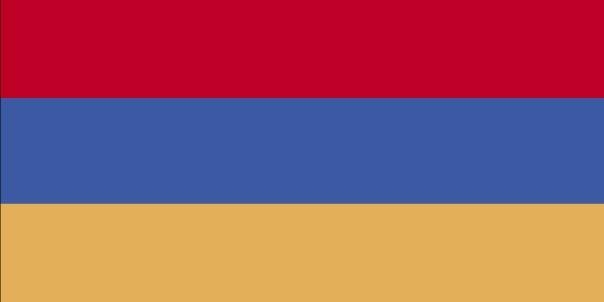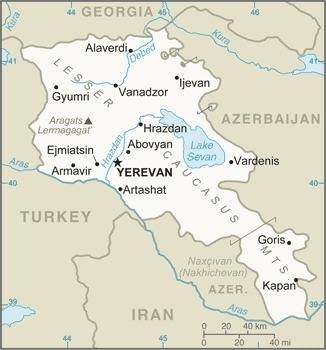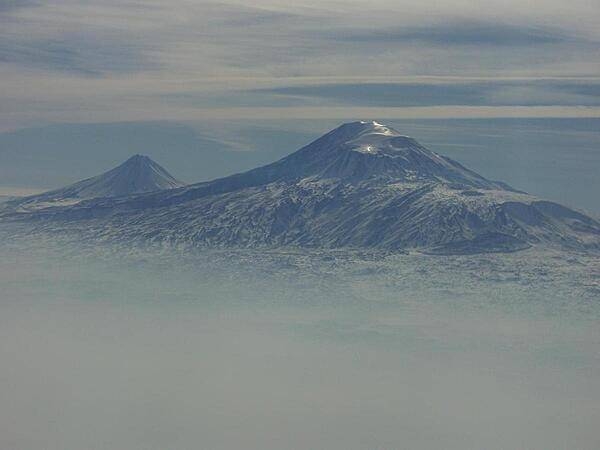127 Armenia

Three equal horizontal bands of red (top), blue, and orange. Red recalls the blood shed for liberty, blue the Armenian skies as well as hope, and orange the land and the courage of the workers who farm it.
Flag courtesy of the CIA World Factbook

Map courtesy of the CIA World Factbook

A view of Mount Ararat in western Turkey through the fog. The highest of its two peaks, Greater Ararat, is the tallest mountain in Turkey at 5,166 m (16,949 ft). Although located some 32 km (20 mi) from the Armenian border, the dormant volcano dominates the skyline of Yerevan, Armenia’s capital. This photo was snapped after take off from the Yerevan airport.
Photo courtesy of the CIA World Factbook
Government
According to Britannica, in 1995 Armenia adopted a new constitution, replacing the Soviet-era constitution that had been in force from 1978. The 1995 document establishes legislative, executive, and judicial branches of government and provides for a strong executive. A number of basic rights and freedoms of citizens are enumerated. The constitution has since been amended twice through referendum: once in 2005 and once in 2015.
Armenia is a unitary multiparty republic. Legislative authority is vested in a 105-member National Assembly. Members are elected to five-year terms. The legislature has the authority to approve the budget, ratify treaties, and declare war.
The head of state is the president, elected by the National Assembly and limited to one seven-year term. The president’s role is largely ceremonial and primarily consists of executing decisions of the National Assembly or the cabinet pertaining to government positions, foreign relations, or the armed forces. The prime minister is the head of government and commander in chief of the armed forces and is elected by a parliamentary majority and subsequently appointed by the president. Upon resignation of the prime minister, the National Assembly must elect a new prime minister within two votes in two weeks. If a new prime minister is not elected within two votes in two weeks, the National Assembly is dissolved and early elections are triggered.
The judiciary consists of trial courts, appellate courts, a Court of Cassation (the highest appellate court), and a nine-member Constitutional Court, which determines the constitutionality of legislation and executive decrees. The members of these courts are appointed variously: most judicial appointments are elected or recommended by the National Assembly, while others are appointed by the president at the recommendation of a judicial council.
Armenia is divided into numerous marzer (provinces). Local authority at the community level is held by mayors or village elders.
During the Soviet period political life was directed by the Communist Party of Armenia, which was controlled by the Communist Party of the Soviet Union. The Armenian National Movement, a moderate nationalist party, governed Armenia from independence until 1998. Major parties in the 21st century have included the conservative Republican Party of Armenia, which dominated the government from 1999 through 2018, and the centre-right Prosperous Armenia Party, founded by businessman Garik Tsarukyan. In 2018 a series of popular protests led by Nikol Pashinyan upended Republican dominance in favor of the populist My Step Alliance.
Armenia was a founding member of the Commonwealth of Independent States. In 1992 Armenia joined the United Nations.
Civil Aviation Committee
The Civil Aviation Committee of the Republic of Armenia was created by the Order N 37-L of the Minister of Territorial Administration and Infrastructure of the Republic of Armenia dated June 10, 2020.
Airspace
SkyVector – Google Maps – ADS-B Exchange
ICAO countries publish an Aeronautical Information Publication (AIP). This document is divided into three parts: General (GEN), En Route (ENR) and Aerodromes (AD). ENR 1.4 details the types of airspace classes they chose to adopt from classes A through G.
ARMATS
“Armenian Air Traffic Services” (“ARMATS”) CJSC is a 100% state-owned commercial organization with a status of a legal entity, established to provide the following air navigation services within the airspace of the Republic of Armenia (“Yerevan” Flight Information Region (FIR))
Drone Regulations
Advanced Air Mobility (AAM) Regulations & Policies
None found by the author.
However, should you, the reader, happen to stumble across something to the contrary, please email the author at FISHE5CA@erau.edu and you may be mentioned in the ACKNOWLEDGEMENTS section of this book by way of thanks for contributing to this free eBook!
Advanced Air Mobility (AAM) News
None found by the author.
However, should you, the reader, happen to stumble across something to the contrary, please email the author at FISHE5CA@erau.edu and you may be mentioned in the ACKNOWLEDGEMENTS section of this book by way of thanks for contributing to this free eBook!
Short Essay Questions
Scenario-Based Question
You have been hired by a Drone Startup Company. Your boss has immediately assigned this job to you.
They need you to prepare a one-page memo detailing the legalities of using a drone to film Mount Ararat, pictured above.
They need you to mention any national laws and local ordinances.
They specifically want to know what airspace (insert pictures) you will be operating in and whether or not you need an airspace authorization.
Does it matter whether or not you are a citizen of the country?
Lastly, there is a bonus for you if, as you scroll through this chapter, you find any typos or broken links!
Short Essay Questions
- What are the drone categories?
- How is registration addressed?
- How is remote ID addressed?
- What are the model aircraft rules?
- What are the commercial drone rules?
- Are there waivers or exemptions to the rules? If so, for what?
- Would you share a link to an interactive airspace map?
- How is BVLOS addressed?
- How can you fly drones at night?
- How can you fly drones over people?
- Where do you find drone NOTAMs?
- What are the rules for drone maintenance?
- What are the rules for an SMS program?
- What are some unique rules not mentioned above?
- What are the C-UAS rules?
- What are the AAM rules?

